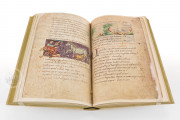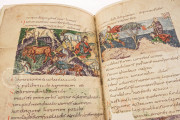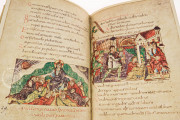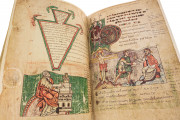The Stuttgart Psalter is one of the most important surviving Carolingian manuscripts due to its extensive biblical pictorial cycle comprising over three hundred individually illustrated scenes. Each psalm begins with an ornamented initial, the style of which suggests an origin at Saint-Germain-des-Prés ca. 820–830. Few of its pages are without elaborate, colorful miniatures that are filled with figures, who are theatrically expressive in their gestures.
The manuscript’s text is a fine Caroline minuscule. Additional exegetical marginal annotations date from the following century. Major divisions are set off with enlarged, decorated capitals and rubricated titles in Roman Rustic capitals. The book’s original ownership is unknown, but was certainly created for an elite member of Carolingian society. The Stuttgart Psalter is a unique manuscript that preserves one of the most extensive cycles of biblical illumination from the early Middle Ages.
Over Three Hundred Colorful Biblical Illustrations
The manuscript is localized to the abbey in Saint-Germain in modern-day France due to the style of its decorated initials. Each psalm begins with an ornate letter that terminates in foliate designs and is sometimes filled with simple interlace. Over three hundred illustrations of biblical scenes are full of energy and detail.
The general style of the hundreds of images looks to northern Italy. This suggests either an artist trained in that region or access to an exemplar from which the biblical illustrations were drawn. Other aspects of the manuscript appear connected to Last Antique and Byzantine sources indicating the broad artistic influences that contributed to Carolingian art.
A Richly Illuminated Carolingian Psalter
The Stuttgart Psalter sits alongside the contemporaneous Utrecht Psalter as an example of the tradition of richly illustrated Carolingian psalters. However, the Stuttgart Psalter has twice as many illuminations, all densely colored with vibrant green, red, purple, and brown pigments that still retain their jewel-like quality.
This extensive pictorial cycle, paired with an elegant Caroline minuscule and large, decorated initials introducing each psalm and section, suggest this manuscript was made for an important patron or as a gift for the nobility.
A Treasure Hidden for Centuries
Beyond its probable creation in the abbey of Saint-Germain, nothing is known about the origins of the Stuttgart Psalter. Because it was not used as an exemplar for other manuscripts, it was probably kept in private, rather than monastic, ownership.
The earliest record of it dates to 1787 when it was described in a letter to Charles Eugene, the Duke of Württemberg, from his librarians when it entered their collection as a gift from Daniel Gottlieb Friedrich Faber. Daniel Faber may have inherited it from his grandfather, Gottlieb Friedrich Faber, who served as a personal physician to the Neuenstadt branch of the Dukes of Württemberg, from whom he may have received it.
The cover of the Stuttgart Psalter is plain parchment stretched over wood. A pattern of drilled holes suggests it was once ornamented with a decorated revetment. The inside of the cover bears transferred texts that have stained the board from now-missing folios in both Caroline minuscule and a later Gothic script.
We have 1 facsimile edition of the manuscript "Stuttgart Psalter": Stuttgarter Bilderpsalter facsimile edition, published by E. Schreiber Graphische Kunstanstalten, 1965
Request Info / Price





















